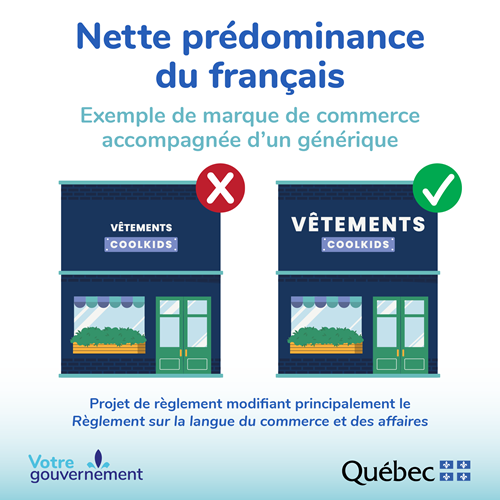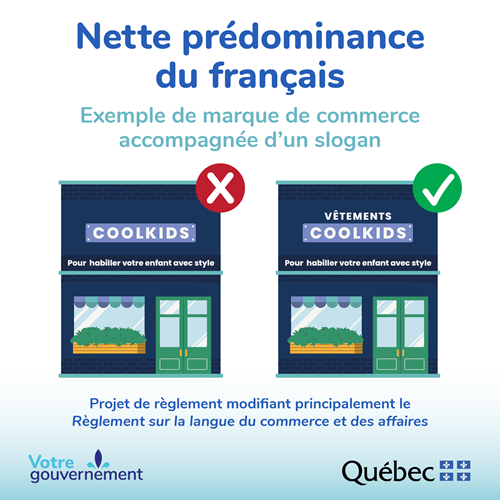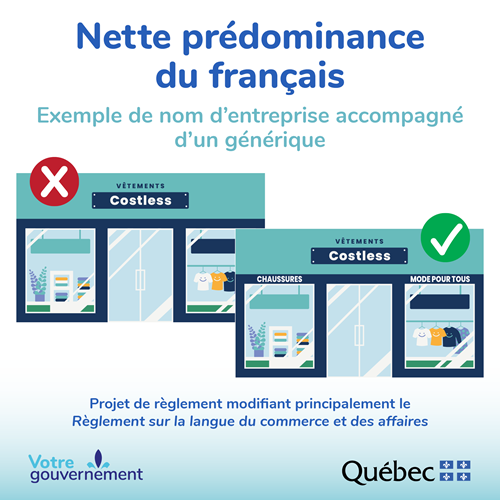Le 10 janvier 2024, le gouvernement du Québec a publié son très attendu projet de Règlement modifiant principalement le Règlement sur la langue du commerce et des affaires (le projet de règlement).
S’il est adopté dans sa mouture actuelle, le projet de règlement porterait application du projet de loi 96 (adopté le 1er juin 2022), lui-même source d’importantes modifications à la Charte de la langue française (la « Charte »). L’effet considérable des exigences du projet de loi 96 sur les entreprises qui mènent des activités au Québec se fait déjà sentir. Celles-ci touchent en particulier la publicité sous toutes ses formes, y compris l’affichage public, la publicité numérique et les emballages et étiquettes de produits. Le projet de règlement a pour objet d’appuyer le projet de loi 96 et d’en clarifier certains termes. Il vise également à modifier le Règlement sur la langue du commerce et des affaires et à révoquer le Règlement précisant la portée de l’expression « de façon nettement prédominante » pour l’application de la Charte de la langue française. Les principales modifications proposées à propos de l’affichage public sont examinées ci-dessous. Pour en savoir plus sur les principales modifications proposées concernant les inscriptions sur les produits, lisez ce billet.
Affichage public
Régime actuel (en vigueur jusqu’au 1er juin 2025)
En principe, sous le régime actuel, l’affichage public et la publicité commerciale au Québec doivent être en français. Ils peuvent être à la fois en français et en une autre langue, mais la version française doit être nettement prédominante par rapport à l’autre.
Cette règle générale a plusieurs exceptions, dont celle de la « marque de commerce reconnue », laquelle permet l’emploi, sans traduction française, de marques de commerce dans une langue autre que le français (p. ex. en anglais seulement) – qu’elles soient déposées ou non – dans l’affichage public et la publicité commerciale. Cette exception ne s’applique que si le texte en question est une marque de commerce reconnue pour laquelle il n’existe aucune version française dans le Registre canadien des marques de commerce. De plus, lorsque des marques de commerce sont affichées devant un commerce, une « présence suffisante du français » doit être assurée dans le même champ visuel.
Modifications proposées par le projet de loi 96 (en vigueur à compter du 1er juin 2025)
Le projet de loi 96 ajoute une restriction importante quant à l’apparence de l’affichage public visible depuis l’extérieur d’un local (p. ex. l’affichage placé devant un commerce).
Sous le régime du projet de loi 96, l’exception relative aux « marques de commerce reconnues » permet l’emploi, sans traduction, de marques de commerce déposées dans une langue autre que le français dans l’affichage public et la publicité commerciale, mais tel n’est pas le cas pour l’affichage public visible sur la devanture d’un commerce ou de l’extérieur de celui-ci. Dans ces situations, le texte en français devra être nettement prédominant. Cette restriction doit entrer en vigueur le 1er juin 2025.
Il est intéressant de noter que selon le projet de règlement, les demandes d’enregistrement de marques de commerce en instance ne tombent pas sous le coup de l’exception relative aux marques de commerce reconnues.
Projet de règlement (publié le 10 janvier 2024)
Le projet de règlement publié par le gouvernement du Québec prévoit les modifications suivantes :
- Définition révisée de l’expression « de façon nettement prédominante » : Selon la définition en vigueur, prévoir deux fois plus d’affichages ou d’affiches en français qu’en toute autre langue ou un espace deux fois plus important, dans un affichage ou sur une affiche, que celui alloué à toute autre langue serait conforme à l’exigence de nette prédominance.
Le projet de règlement prévoit l’abrogation du règlement particulier définissant l’expression « de façon nettement prédominante » et son remplacement par une nouvelle définition établissant l’exigence que le texte en français ait « un impact visuel beaucoup plus important que le texte rédigé dans une autre langue ».
En pratique, cela signifie qu’à l’intérieur d’un même champ visuel (c.-à-d. un même affichage visible et lisible simultanément, sans que le lecteur ait à bouger) :
- le texte français doit être au moins deux fois plus grand que celui rédigé dans une autre langue;
- sa lisibilité et sa visibilité permanente doivent être équivalentes à celles du texte rédigé dans une autre langue.
On entend par « visibilité permanente » le fait de ne pas pouvoir être facilement retiré ou arraché.
L’exigence voulant que le texte français d’un affichage public soit « deux fois plus grand » que celui rédigé dans une autre langue ne vise pas forcément tout le texte français. Le choix des éléments à représenter de cette façon (c.-à-d. deux fois plus grands que les autres) dépendra du nombre d’éléments en français dans l’affichage public. Ainsi, si un seul terme français figure sur l’affichage placé en devanture d’un commerce, celui-ci devra être deux fois plus grand que le terme anglais (même si ce dernier est une marque de commerce déposée). Toutefois, si plusieurs éléments en français apparaissent sur l’affichage en devanture d’un commerce, c’est l’espace total consacré au français qui dictera l’application de l’exigence voulant que le texte français soit « deux fois plus grand ». Autrement dit, l’espace total occupé par le texte français (y compris toute marque de commerce déposée) devra être deux fois plus grand que l’espace total alloué au texte anglais (ou dans une autre langue), marques de commerce déposées comprises.
Les exemples suivants, fournis par le gouvernement du Québec, montrent un emploi d’une marque de commerce dans un affichage en devanture d’un commerce qui serait jugé conforme à la nouvelle exigence de « nette prédominance » lorsqu’un seul élément en français est ajouté.

Source: Gouvernement du Québec
Exemple 1 : Une marque de commerce en anglais seulement est accompagnée d’un seul descriptif français des biens offerts (« vêtements »). Le projet de règlement exige que le texte français soit nettement prédominant par rapport au texte dans une autre langue (c.-à-d. qu’il prenne deux fois plus d’espace que celui-ci), marque de commerce comprise. Comme il n’y a qu’un seul élément en français dans le champ visuel, celui-ci doit être deux fois plus gros que la marque de commerce en anglais uniquement.
- Visibilité depuis l’extérieur d’un local : Le projet de règlement clarifie la portée de l’expression « visible depuis l’extérieur d’un local » utilisée dans la Charte. Dorénavant, ce qui est « visible depuis l’extérieur d’un local » comprend à la fois ce qui est visible à l’extérieur d’un bâtiment et ce qui est visible devant un commerce dont l’entrée est à l’intérieur d’un bâtiment, par exemple dans un centre commercial.
- Ajout d’un élément français pour assurer une nette prédominance : Lorsqu’une marque de commerce dans une autre langue que le français figure dans un affichage public visible depuis l’extérieur d’un local, un énoncé français doit être ajouté de sorte que le français soit nettement prédominant, par exemple un générique, un descriptif des produits et services offerts ou un slogan. Bien que le projet de loi 96 prévoie une exigence similaire, le gouvernement du Québec a fourni d’autres exemples où le français serait considéré comme nettement prédominant (c.-à-d. comme occupant deux fois plus d’espace que les autres langues) selon les nouvelles exigences.


Source: Gouvernement du Québec
Exemples 2 et 3 : Des affiches où figurent des marques de commerce dans une langue autre que le français et plusieurs expressions descriptives (« vêtements », « chaussures ») et slogans (« Pour habiller votre enfant avec style », « Mode pour tous ») en français.
Ces exemples suggèrent que, selon la quantité de texte français figurant dans un affichage public visible depuis l’extérieur d’un local, l’exigence d’« impact visuel beaucoup plus important » peut être satisfaite sans qu’il faille rendre chaque élément textuel en français deux fois plus gros que le texte dans une autre langue. C’est en effet dans son intégralité, et non en chacun de ses éléments, que le français doit occuper deux fois plus d’espace que toute autre langue.
Au vu des exemples 1, 2 et 3 ci-dessus, il semblerait qu’une manière de faire en sorte que les marques de commerce dans une langue autre que le français figurent de façon évidente dans l’affichage en devanture d’un commerce tout en étant conformes à la nouvelle définition proposée de « nette prédominance » consiste à ajouter plusieurs génériques, descriptifs et slogans.
Comment se préparer à l’entrée en vigueur éventuelle du Règlement
Bien que le projet de règlement soit soumis à une période de consultation de 45 jours (lancée le 10 janvier 2024), et que nous n’en connaissons donc toujours pas la version définitive, il y a lieu pour les exploitants de commerces physiques au Québec d’agir en amont pour que l’affichage de leurs commerces soit conforme aux exigences du projet de loi 96 et du projet de règlement.
1. Veiller à ce que ses marques de commerce soient déposées. Comme aucune disposition ne prévoit que les marques de commerce dont l’enregistrement est en cours doivent être considérées comme déposées aux fins de l’affichage public et de la publicité commerciale, toute marque de commerce dans une langue autre que le français qui figure dans l’affichage public et la publicité commerciale, mais qui n’a pas été enregistrée en date du 1er juin 2025 devra être traduite.
Cette nouvelle disposition aura une incidence considérable sur les entreprises qui mènent des activités au Québec, les échéances actuelles de l’Office de la propriété intellectuelle du Canada étant telles qu’une demande d’enregistrement déposée avant la date du présent bulletin pourrait bien ne pas aboutir avant le 1er juin 2025.
Ainsi, il y a lieu d’examiner son portefeuille de marques de commerce afin de veiller à ce que toute marque figurant dans un affichage ou une publicité commerciale tombant sous le coup du Règlement soit déposée, ou que son enregistrement soit renouvelé. Nous encourageons également les propriétaires d’entreprises à se renseigner sur la possibilité de faire accélérer le traitement de leurs demandes en cours.
2. Examen des restrictions d’affichage applicables Beaucoup disposent d’un espace d’affichage limité devant leurs commerces. Ces limites peuvent viser la taille de l’affichage ou découler de restrictions réglementaires ou municipales.
Or, pour assurer une nette prédominance du français, l’ajout de texte français s’imposera vraisemblablement; celui-ci devra être lisible et visible à titre permanent, au même titre que tout autre texte présenté. Les propriétaires d’entreprise devront donc s’assurer que le français ait dans l’ensemble un « un impact visuel beaucoup plus important » que le texte présenté dans toute autre langue (c.-à-d. qu’il occupe deux fois plus d’espace que les autres langues en étant tout aussi lisible et visible de façon permanente qu’elles) avant d’engager des frais pour modifier l’affichage extérieur de leur commerce.
3. Conception de nouveaux génériques, slogans et descriptifs. Vu l’échéance du 1er juin 2025, les propriétaires d’entreprises seraient avisés de faire appel à leurs équipes de marketing pour concevoir de nouveaux génériques, slogans et descriptifs, qu’il s’agisse de termes ou d’expressions, à ajouter à leur affichage en devanture de commerce pour rendre celui-ci conforme. Outre la quantité d’éléments français ajoutés, les entreprises devront positionner ceux-ci pour qu’ils occupent deux fois plus d’espace que les autres éléments, et qu’ils soient tout aussi lisibles et visibles de façon permanente que ceux-ci. Le défi consistera à respecter ces exigences sans sacrifier l’attrait externe du commerce.
Si vous avez des questions sur le projet de règlement, les exigences du projet de loi 96, la Charte de la langue française ou leur application au Québec, nous vous invitons à communiquer avec les auteurs de ce bulletin et vos personnes-ressources au sein des équipes de Propriété intellectuelle et des Affaires réglementaires.
Lisez notre bulletin connexe : Partie I – Inscriptions sur les produits




